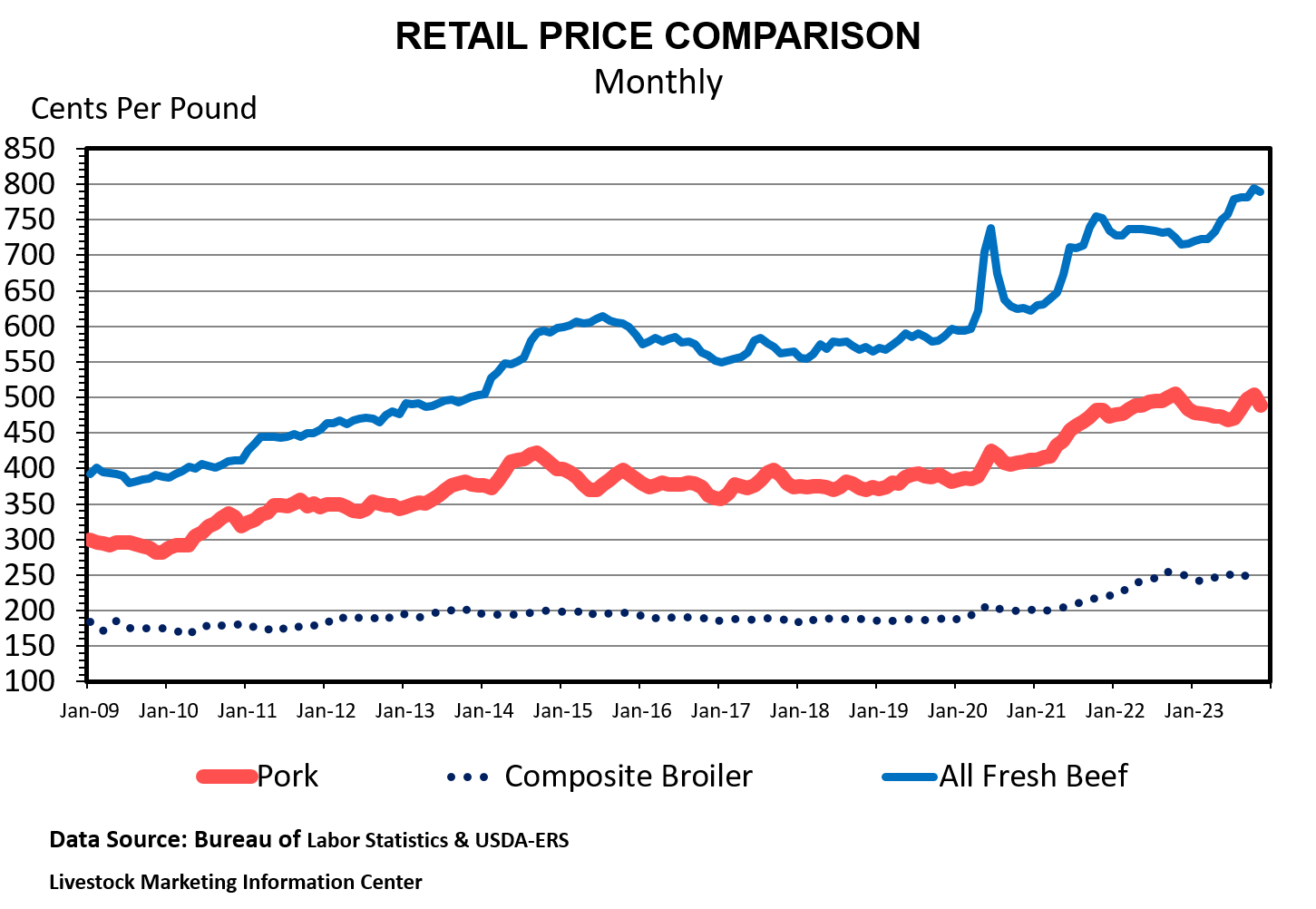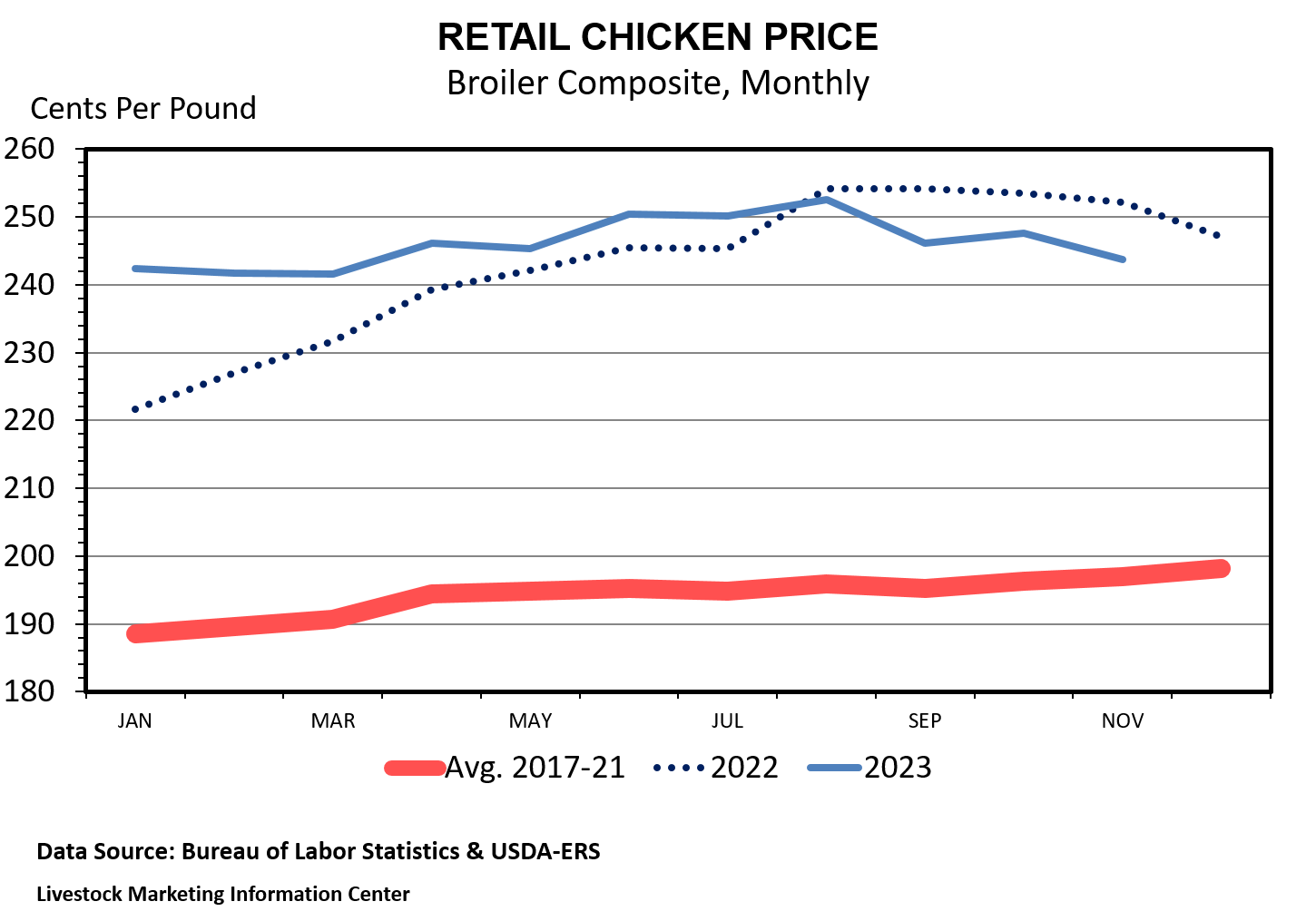Main Takeaways
- The broiler chicken outlook in 2024 is neutral to positive as consumer demand is expected to remain steady and feed costs come down.
- Risks to the chicken outlook include significant HPAI outbreaks and expensive housing.
- Overall, baseline chicken prices are expected to be similar to 1-year-ago levels. Production uncertainty is the main driver of price uncertainty for 2024.
2024 Poultry Outlook
Chicken prices have been on a bit of a roller coaster for the last couple of years. After 2021’s year-over-year drop in prices, 2022 saw prices rebound on tighter supplies, with very high prices in the summer of 2022. In 2023, prices dropped slightly at the wholesale level as supplies started to build in the last quarter of 2022, and production increased slightly in 2023. However, retail prices remained elevated throughout the year.
In the year ahead, the outlook is generally steady with potential challenges. In aggregate, small increases in demand and supply will generally balance each other out, leading to similar price levels to 2023. U.S. consumer demand for chicken is expected to remain steady amid consistent consumer taste trends and expensive protein alternatives (see Figure 1). U.S. production may face more headwinds than the demand side. Potential HPAI outbreaks, a trend of lower broiler productivity, and expensive poultry housing may dampen supplies. Policy changes may also affect the financial outlook.

From the Bureau of Labor Statistics and USDA ARS Livestock Marketing Information Center.
U.S. consumer demand is expected to remain steady in 2024. Per capita chicken consumption is estimated at around 100 pounds in 2023. Consumption per person will likely remain relatively close to this benchmark in 2024, while aggregate consumption will increase as the population grows. Domestically, chicken is priced competitively with pork and especially beef. This will be supportive of domestic chicken consumption through 2024. USDA export projections for 2024 are similar to the last two years with a slight increase year-over-year. Economic headwinds in overseas markets may hinder exports.
U.S. chicken production is expected to increase incrementally in 2024 according to the USDA. This forecast has significant uncertainty. While broiler layer numbers have increased year-over-year through 2023, eggs per layer have dropped through the year. Total eggs set and total chicks placed are higher than the five-year average, but were well below year-ago levels through the fall. Hatchability does not appear to show significant trends since a decline in 2021, and survivability appears to have a similar flat line trend.
The factors that may increase production would be changes in layer productivity, higher weights, and feed costs. If the layer productivity or hatchability productivity factors improve in 2024, production may increase more than expected. Additionally, broiler weights have been trending higher, and this trend is expected to continue into 2024. Lastly, feed costs have come down significantly over the last 12 to 18 months. As a result, the profitability of producing chickens has improved dramatically compared to late 2022 and early 2023. Improved profit prospects from lower feed costs could spur additional production. These profit prospects may erode if these lower feed costs are pushed through to the end consumer.
Retail chicken prices have largely remained steady since the run-up in prices during 2022 (see Figure 2). However, the latter half of 2023 showed some weakness in chicken prices year-over-year. Boneless, skinless chicken breast is the biggest driver of chicken prices. Boneless, skinless chicken breast prices were well above 2022 levels until May and slid lower through the end of the year. Leg prices saw a similar pattern, but the drop below year-ago levels did not occur until the fall. Wholesale prices have had a different story with 2023 prices showing relative strength this fall.

From the Bureau of Labor Statistics and USDA ARS Livestock Marketing Information Center.
2024 may face challenges in the year ahead on the production side due to Highly Pathogenic Avian Influenza (HPAI) and expensive housing. While HPAI tends to impact turkey and table egg operations more than broiler production, the risk remains. Because of the lower number of chicks hatched per layer, more layers are needed to maintain or increase production. This potentially increases the risk of exposure between layers and HPAI.
As more layers are needed, more breeder houses need to be constructed. These houses, along with production houses, are expensive. Auburn University estimates suggest typical broiler farms could cost upwards of $5 million. These create significant startup costs for smaller producers. To the extent these costs restrict new house construction, production growth may be curtailed.
Chicken prices in 2024 are expected to be similar to 2023 in the baseline expectation. However, there is considerable uncertainty to production. If production growth exceeds expectations, chicken prices may drop year-over-year. However, if production is smaller than anticipated, chicken prices may increase.
Status and Revision History
In Review on Jan 19, 2024
Published on Jan 22, 2024


























































